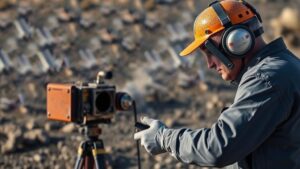Detecting for Coins and Relics Under Concrete or Asphalt Surfaces
Introduction to Detecting for Coins and Relics Under Concrete or Asphalt Surfaces
Detecting for coins and relics under concrete or asphalt surfaces presents unique challenges and opportunities for treasure hunters and archaeologists alike. The advent of advanced metal detectors has transformed the landscape of treasure hunting, allowing enthusiasts to uncover hidden artifacts that lie beneath modern roadways and structures. This article delves into the techniques, technologies, and considerations that play a critical role in effectively detecting valuable items under these hard surfaces.
Understanding the Challenges
Signal Interference and Depth Analysis
Concrete and asphalt are dense materials that can attenuate the signals emitted by metal detectors. This interference can significantly reduce the likelihood of detecting coins and relics buried beneath these surfaces. The depth of the object also plays a crucial role; metal detectors generally have a limited effective range, which diminishes as the distance to the target increases. To illustrate, while a high-quality metal detector can typically detect objects up to 12 inches deep in soil, this range can be reduced to just 4-6 inches when faced with concrete or asphalt.
Legal and Ethical Considerations
Prior to detecting under concrete or asphalt, it is imperative to understand the legal implications of searching in public or private property. Local laws often govern the use of metal detectors, especially in urban areas. For example, in many municipalities, digging or disturbing asphalt or concrete surfaces without permission can lead to fines or legal repercussions. Respecting local regulations is not only vital but essential to maintain good relations with property owners and municipal authorities.
Detection Techniques
Selecting the Appropriate Metal Detector
Choosing the right metal detector is critical when working under concrete or asphalt. Various models cater specifically to this niche, such as pulse induction detectors and low frequency (VLF) detectors. Pulse induction detectors, known for their ability to penetrate dense materials, are particularly effective for locating deep targets. In contrast, VLF detectors may require more finesse in their use but can provide excellent sensitivity to smaller, shallow targets.
Techniques for Effective Detection
To maximize detection success, hunters can employ several techniques:
- Ground Penetrating Radar (GPR): This technology allows for the visualization of subsurface objects, offering a non-intrusive method to identify potential targets before excavation.
- Magnetic Detection: Employing magnetic detectors can help locate ferromagnetic objects beneath solid surfaces. This method is particularly useful for larger relics.
- Electromagnetic Induction: Utilizing electromagnetic induction technology can help detect non-ferrous metals more effectively under pavement.
Case Studies and Applications
Urban Archaeology Projects
Mediums such as cities are rife with historical artifacts buried beneath layers of modern infrastructure. One notable example occurred in Chicago, where researchers employed GPR technology to locate remnants of the original fortifications predating the city. Their findings included buried weaponry and personal effects that provided insight into the lives of early settlers.
Coin Recovery in Historical Contexts
In another case, a treasure hunter utilized a combination of metal detectors and GPR in a former amusement park, now asphalt-covered, where children once played. hunt led to the discovery of hundreds of coins that dated back to the early 20th century, all valuable pieces of local history.
Conclusion: Moving Forward in the Field
Detecting for coins and relics under concrete and asphalt surfaces is a complex but rewarding endeavor. By understanding the challenges posed by these materials and employing specialized techniques along with the right tools, treasure hunters can uncover significant historical artifacts while abiding by legal and ethical norms. As technology evolves, the methods of detecting and recovering these hidden treasures will continue to improve, promising an exciting future for enthusiasts in this field.
Actionable Takeaways
- Invest in specialized equipment such as pulse induction metal detectors or GPR for improved performance.
- Always research local laws regarding metal detecting to avoid legal issues.
- Use techniques like magnetic detection and electromagnetic induction for enhanced recovery rates.
- Engage with local archaeological groups to gain insights and knowledge about successful detection practices.


